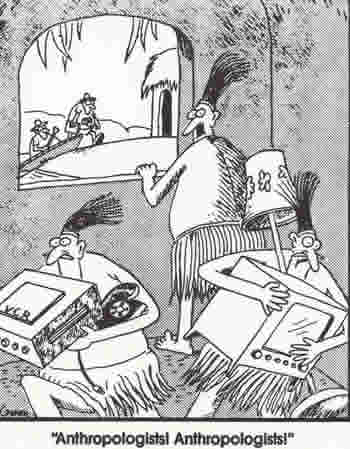Next!
 In this class you've learned some of the basic tools and concepts of anthropology.
In this class you've learned some of the basic tools and concepts of anthropology.
Examining different kinds of societies has let us think about the variability of culture and the ways that ideologies, technologies, power, war peace, family, religion, and many other aspects of society vary and interact.
You've learned how anthropologists understand and analyze society. You have begun to learn to think anthropologically.
Now its for YOU to develop and use those skills. I hope you'll take more ANTH courses. But, even if you don't, I hope you'll be able to bring a little anthropological insight to whatever you do!
general topic review
Thanks much for taking this course. I'd be really happy to see any of you in other classes that I teach. In Fall 2025, I'll be teaching ANTH 3309, Culture and Film. In that class we examine the history of film and the relationship of film and culture. We see a series of full length classic movies. I'll also be teaching a graduate level theory class. In Spring 2026, I'll be teaching this class again and I'll be teaching ANTH 3360, Economic Anthropology. That's a much smaller class, limited to about 25 students. We take a detailed look at how societies produce, distribute, and consume and at the insights we get from thinking about culture from an economic viewpoint. Part of that class is seminar style: we read full length books together and then discuss them.
Texas State University offers Master's and Doctoral degrees in anthropology that focuses on applied anthropology. I teach introductory and advanced theory in that program. If you're interested in pursuing graduate education in anthropology, here or elsewhere, please come and talk to me!
Please keep in touch! I'll always be glad to hear from you.
*****
A final thought:
Alice never could quite make out, in thinking it over afterwards, how it was that they began: all she remembers is, that they were running hand in hand, and the Queen went so fast that it was all she could do to keep up with her: and still the Queen kept crying “Faster! Faster!” but Alice felt she could not go faster, though she had not breath left to say so.
The most curious part of the thing was, that the trees and the other things round them never changed their places at all: however fast they went, they never seemed to pass anything. “I wonder if all the things move along with us?” thought poor puzzled Alice. And the Queen seemed to guess her thoughts, for she cried, “Faster! Don’t try to talk!”
Not that Alice had any idea of doing that. She felt as if she would never be able to talk again, she was getting so much out of breath: and still the Queen cried “Faster! Faster!” and dragged her along. “Are we nearly there?” Alice managed to pant out at last.
“Nearly there!” the Queen repeated. “Why, we passed it ten minutes ago! Faster!” And they ran on for a time in silence, with the wind whistling in Alice’s ears, and almost blowing her hair off her head, she fancied.
“Now! Now!” cried the Queen. “Faster! Faster!” And they went so fast that at last they seemed to skim through the air, hardly touching the ground with their feet, till suddenly, just as Alice was getting quite exhausted, they stopped, and she found herself sitting on the ground, breathless and giddy.
The Queen propped her up against a tree, and said kindly, “You may rest a little now.”
Alice looked round her in great surprise. “Why, I do believe we’ve been under this tree the whole time! Everything’s just as it was!”
“Of course it is,” said the Queen, “what would you have it?”
“Well, in our country,” said Alice, still panting a little, “you’d generally get to somewhere else—if you ran very fast for a long time, as we’ve been doing.”
“A slow sort of country!” said the Queen. “Now, here, you see, it takes all the running you can do, to keep in the same place. If you want to get somewhere else, you must run at least twice as fast as that!”
---Lewis Carroll, Through the Looking Glass (1871), Chapter 2.
 In this class you've learned some of the basic tools and concepts of anthropology.
In this class you've learned some of the basic tools and concepts of anthropology.